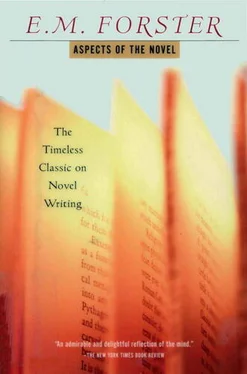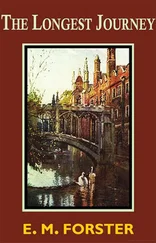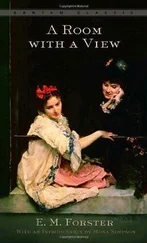It is a good answer, it will lead on to some sound conclusions. Yet it is not satisfactory for a novel like Moll Flanders, where the character is everything and can do what it likes. We want a reply that is less aesthetic and more psychological. Why cannot she be here? What separates her from us? Our answer has already been implied in that quotation from Alain: she cannot be here because she belongs to a world where the secret life is visible, to a world that is not and cannot be ours, to a world where the narrator and the creator are one. And now we can get a definition as to when a character in a book is real: it is real when the novelist knows everything about it. He may not choose to tell us all he knows—many of the facts, even of the kind we call obvious, may be hidden. But he will give us the feeling that though the character has not been explained, it is explicable, and we get from this a reality of a kind we can never get in daily life.
For human intercourse, as soon as we look at it for its own sake and not as a social adjunct, is seen to be haunted by a spectre. We cannot understand each other, except in a rough and ready way; we cannot reveal ourselves, even when we want to; what we call intimacy is only a makeshift; perfect knowledge is an illusion. But m the novel we can know people perfectly, and, apart from the general pleasure of reading, we can find here a compensation for their dimness in life. In this direction fiction is truer than history, because it goes beyond the evidence, and each of us knows from his own experience that there is something beyond the evidence, and even ii the novelist has not got it correctly, well—he has tried. He can post his people in as babies, he can cause them to go on without sleep or food, he can make them be in love, love and nothing but love, provided he seems to know everything about them, provided they are his creations. That is why Moll Flanders cannot be here, that is one of the reasons why Amelia and Emma cannot be here. They are people whose secret lives are visible or might be visible: we are people whose secret lives are invisible.
And that is why novels, even when they are about wicked people, can solace us; they suggest a more comprehensible and thus a more manageable human race, they give us the illusion of perspicacity and of power.
WEnow turn from transplantation to acclimatization. We have discussed whether people could be taken out of life and put into a book, and conversely whether they could come out of books and sit down in this room. The answer suggested was in the negative and led to a more vital question: can we, in daily life, understand each other? Today our problems are more academic. We are concerned with the characters in their relation to other aspects of the novel; to a plot, a moral, their fellow characters, atmosphere, etc. They will have to adapt themselves to other requirements of their creator.
It follows that we shall no longer expect them to coincide as a whole with daily life, only to parallel it. When we say that a character in Jane Austen, Miss Bates for instance, is "so like life" we mean that each bit of her coincides with a bit of life, but that she as a whole only parallels the chatty spinster we met at tea. Miss Bates is bound by a hundred threads to Highbury. We cannot tear her away without bringing her mother too, and Jane Fairfax and Frank Churchill, and the whole of Box Hill; whereas we could tear Moll Flanders away, at least for the purposes of experiment. A Jane Austen novel is more complicated than a Defoe, because the characters are inter-dependent, and there is the additional complication of a plot. The plot in Emma is not prominent and Miss Bates contributes little. Still it is there, she is connected with the principals, and the result is a closely woven fabric from which nothing can be removed. Miss Bates and Emma herself are like bushes in a shrubbery—not isolated trees like Moll—and anyone who has tried to thin out a shrubbery knows how wretched the bushes look if they are transplanted elsewhere, and how wretched is the look of the bushes that remain. In most books the characters cannot spread themselves. They must exercise a mutual restraint.
The novelist, we are beginning to see, has a very mixed lot of ingredients to handle. There is the story, with its time-sequence of "and then . . . and then . . ."; there are ninepins about whom he might tell the story, and tell a rattling good one, but no, he prefers to tell his story about human beings; he takes over the life by values as well as the life in time. The characters arrive when evoked, but full of the spirit of mutiny. For they have these numerous parallels with people like ourselves, they try to live their own lives and are consequently often engaged in treason against the main scheme of the book. They "run away," they "get out of hand": they are creations inside a creation, and often inharmonious towards it; if they are given complete freedom they kick the book to pieces, and if they are kept too sternly in check, they revenge themselves by dying, and destroy it by intestinal decay.
These trials beset the dramatist also, and he has yet another set of ingredients to cope with—the actors and actresses—and they appear to side sometimes with the characters they represent, sometimes with the play as a whole, and more often to be the mortal enemies of both. The weight they throw is incalculable, and how any work of art survives their arrival I do not understand. Concerned with a lower form of art, we need not worry—but, in passing, is it not extraordinary that plays on the stage are often better than they are in the study, and that the introduction of a bunch of rather ambitious and nervous men and women should add anything to our understanding of Shakespeare and Chekov?
No, the novelist has difficulties enough, and today we shall examine two of his devices for solving them—instinctive devices, for his methods when working are seldom the same as the methods we use when examining his work. The first device is the use of different kinds of characters. The second is connected with the point of view.
I.We may divide characters into flat and round.
Flat characters were called "humorous" in the seventeenth century, and are sometimes called types, and sometimes caricatures. In their purest form, they are constructed round a single idea or quality: when there is more than one factor in them, we get the beginning of the curve towards the round. The really flat character can be expressed in one sentence such as "I never will desert Mr. Micawber." There is Mrs. Micawber—she says she won't desert Mr. Micawber, she doesn't, and there she is. Or: "I must conceal, even by subterfuges, the poverty of my master's house." There is Caleb Balderstone in The Bride of Lammermoor. He does not use the actual phrase, but it completely describes him; he has no existence outside it, no pleasures, none of the private lusts and aches that must complicate the most consistent of servitors. Whatever he does, wherever he goes, whatever lies he tells or plates he breaks, it is to conceal the poverty of his master's house. It is not his idée fixe, because there is nothing in him into which the idea can be fixed. He is the idea, and such life as he possesses radiates from its edges and from the scintillations it strikes when other elements in the novel impinge. Or take Proust. There are numerous flat characters in Proust, such as the Princess of Parma, or Legrandin. Each can be expressed in a single sentence, the Princess's sentence being, "I must be particularly careful to be kind." She does nothing except to be particularly careful, and those of the other characters who are more complex than herself easily see through the kindness, since it is only a by-product of the carefulness.
Читать дальше












